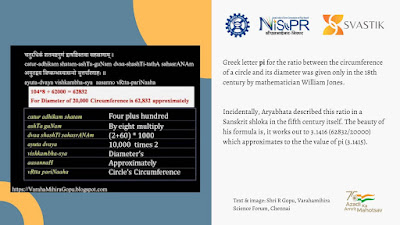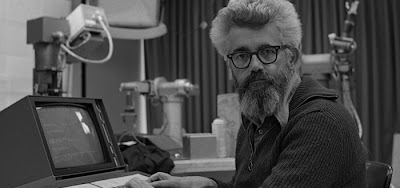 |
| Dashaavatara temple, Deogarh, Uttar Pradesh |
History
We read about the Golden age of the Guptas, but very few
Gupta monuments have survived the destruction. One of them is the Dasavatara
temple in Deogarh, Uttar Pradesh. Even this is not the complete original
temple, but has what has survived the ravages of time. A forlorn fragment of an
amalaka hints that the temple’s vimaana may have been a Rekha Naagari devaalaya.
The temple is on a tall platform, an upapiThaa, with flights of steps leading up
to it from all directions. The moolavigraha of the main moorthi is also absent.
Nearby remnants of the upapitha-s in square sections suggest
that the temple may have once had parivaara shrines all around it. On one side
is a small pond.
But there is an entrance doorway to the sanctum, with
sculptures decorating it. And on the three walls, there are three kostha-s with
three of the most marvelous sculptures in Indian art. We can study these in
detail, appreciate their aesthetic and narrative skill, and compare them to
similar sculptures across India.
There are some temples of the Gupta era in Sanchi, near the
famous stupa. One of these is small and compact but plain and undecorated,
except for the pillars. The other is more elaborate, but has suffered a great
deal of damage. In nearby Vidisha, in the rocky hills of Udayagiri, there are
quite a few cave temples of the Gupta era, also.
But first let us see the three main sculptures.
Gajendra Moksha
The story of Gajendra
Moksha is quite well known, but worth repeating. An elephant, Gajendra, an
ardent devotee of Vishnu is caught by a crocodile when it stepped into a pond;
it screamed out Vishnu’s name for help; Vishnu mounting his vaahana Garuda, instantly came to the rescue,
used his Sudarshana chakra to slay the crocodile and rescued Gajendra. This is
the most popular rendering. In Deogarh, though, a naga (snake) rather than a
crocodile is depicted as attacking Gajendra.
 |
| Gajendra Moksha, Deogarh |
Let us examine this sculpture in
detail. The panel is very rectangular, taller than it is broad, but the figures
inside form graceful curves. Central and dominant is Vishnu, seated on Garuda,
depicted with human face and body and wings. Garuda has infinite strength, so
he comfortably bears a larger Vishnu. This is a conquest, but it is effortless
– the chakra has already been cast and it has split the chest of the Naga. It
is not a battle like Narasimha fighting Hiranya, or Siva destroying Gajaasura.
Not only Vishnu, but every single character seems to have a calm expression,
including the Naga. Remember this is one of the oldest sculptures. The eyes of
the characters all seem closed - I suspect that they were painted in later, but
this has been lost due to erosion. You can see this in every single sculpture
in this temple.
The naga is seven hooded, and is
accompanied by a nagini. Both hold their palms together in surrender and
supplication. The naga’s long coils wrap around the front and back legs of
Gajendra, whose expression is frozen in shock. How does one show water in a
sculpture? With lotuses and creepers, as we saw in the Gajalakshmi panel in Ellora. We see lotuses in
all directions, horizontal, vertical, in profile. Wavy stalks carrying unopened
buds emphasize the turbulence of the pond. The arch of Vishnu over Garuda
dominates the left upper quadrant, and is complemented by the mirroring arch of
the naga in the right lower quadrant. His magnificent hood arches towards us,
but one senses his towering dominance over Gajendra, before the arrival of
Vishnu. Gajendra’s trunk forms a gentle upward arch, the lotus at the tip
touching the very feet of Vishnu; a brilliant touch by the sculptor.
Vishnu’s kirita makuta, also noticeable in the Anantashayana panel, is a
fascinating contrast to all the jatamakutas
of Siva that we have seen in many sculptures, in this series.
Garuda has his right hand in tarjani (warning) mudhra. By showing the
prayoga chakra in Vishnu’s upper right
hand, and also in the Naga’s chest, the sculptor has captured two moments in
time. Vishnu’s lower left hand rests casually on his knee.
Far above, a line separating them
from the action on the ground, hover two sets of gandharva couples, who have
come to witness this leela of Vishnu. The entire panel is set off by
beautifully decorated pilasters, with ghaTapallavas (pot with vines). Patra-toranas climb inner pilasters. A row of vyaaghra-mukhas (tiger faces) above the koshta, and seated lions in
the corners, hint at the inspiration for, and continuity in, all later sculptures
across the land.
 |
Gajendra Moksha, Tirukurungudi, Tamilnadu
Photo – Ashok Krishnaswamy |
This story is depicted in Ellora,
Pattadakkal, Tirukkurungudi etc. The Tirukkurungudi sculpture in a fifteenth
century temple is in Madurai Nayak style. It shows the crocodile, which is much
smaller than Gajendra. Vishnu is eight armed, wielding his sword, bow and
arrow, shield etc. Garuda too wears a crown, and bares fangs, while bearing
Vishnu’s feet with his hands. Two munis, hands in worship, rather than
gandharva-s bearing garlands, bear witness. Vishnu and Garuda are almost
identical to the Deogarh sculpture!
 |
Three versions
Pattadakkal photo – VK Srinivasan |
The Pattadakkal sculptor shows a
huge tortoise, instead of a crocodile or snake, grabbing Gajendra. He depicted
it on a pillar rather than a kostha or a broad wall, so he used space very
differently: Vishnu hasn’t released his chakra; he is not facing the tortoise,
which is unaware of his arrival. But Gajendra’s shock and the lotus pond
setting are very similar. The Ellora version also is very vertical, but the
lower portions have eroded considerably.
The shilpi in Srirangam, working
on a segment of a pillar, ignored the physical act and has shown Vishnu
lovingly petting his elephant, which gambols delightfully at his knees.
Audacity? Tenderness? Both?
 |
| Doorway sculptures, Deogarh |
Before we look at the other two panels, let us examine the
sanctum’s highly decorated doorway. Surya and Chandra serve as dvaarapalakas. ; a
lovely lathaa (creeper) climbs up one side, over Surya across and down the
other, up to Chandra, and features demigods frolicking amidst. The center of
the lintel features Vaikuntanaatha seated on a coiled Adisesha.
The consorts of Surya and Chandra form the base of the next
set of pilasters; mithuna couples alternate with pairs of ganas, and fill the
segments above them. Voluptuous chamaradhaari kanyaa-s form an outer pair; the
pilasters above them have various geometric segments and a couple of dancers.
 |
| Doorway sculptures, Deogarh |
The hair decoration and the ornamentation of mithunas and others extraordinarily elaborate, perhaps more sophisticated than even today’s
styles.
Nara Narayana
The other wall features two munis, two-armed Nara and four-armed
Narayana, at Badari ashrama. Krishna tells Arjuna that the latter was Nara and
himself Narayana in an earlier incarnation. The ashrama is depicted like in the
Kanchi Kailasanatha panel of Dakshinamurthy - with
deer and tigers peacefully seated together.
 |
| Nara Narayana, Deogarh |
There is no action in this panel; it is all serenity. The
two munis are in deep discussion, seated under different trees; shishyaa-s listen
in the background. Other gods come to witness. There is no ornamentation,
except for splendid jatas; their bare clothing bespeaks simplicity. Both
possess akshamaala-s in their right hands, their mudhras convey their message; perhaps
the most remarkable feature, is an antelope’s head marking the clasp of Nara’s
yajnopavita. The auspiciousness of the whole scene is subtly conveyed by
Gajalakshmi in a pilaster under a ghaTa-pallava.
I am yet to see NaraNarayana anywhere else. It seems unique
to Deogarh.
Anantashayana
Gajendra Moksha depicts action; NaraNarayana serenity; the
Anantashayana panel manages to combine these two apparent opposites!
 |
| Anatashayana, Deogarh |
Having passed on the act of creation to Brahma, Vishnu rests
in yoganidra upon Adisesha; Sridevi tends to him. Out of his ears, emerges a
speck which transforms into two asuras Madhu and Kaitabha. They spot the
Almighty in yoganidra, foolishly assume he is asleep, assume they will get his
powers if they kill him, and attack him. While Vishnu is in anantashayana, his
weapons are all awake and alert as aayudha-purusha-s: the chakra Sudarshana, the
shankha Paanchajanya, the sword Nandaka, all male and the gadha Kaumodhaki, a
woman. They proceed to independently take on Madhu and Kaitabha. A ferocious
battle ensues, Adisesha spits venom with his thousand hoods; the asuras run,
unable to withstand the ferocity. The furor disturbs Vishnu’s yoganidra and he
battles the two asuras himself. So goes
the story. But the Deogarh panel shows almost none of this. The sculptor has
chosen to depict only one asura and Nandaka, with weapons drawn; at the
earliest moment of the battle. If anything, this is even more serene than the
NaraNarayana panel, where at least the central figures are wide awake!
Kartikeya on his peacock, Indra on his elephant, Brahma on a
lotus, Siva-Parvati on a bull all witness this extraordinary scene. The seven
hoods of Adisesha form an awesome canopy over the majestic crown of Vishnu. So
we see a tripartite vertical division of the sculpture.
This particular scene is a pan-national favorite, especially
in the south, where several temples like Srirangam, Srirangapatnam,
Thiruvananthapuram, Thirumeyyam, Yatoktakaari in Kanchipuram, all feature Anantashayana
as the moolamurthi in the garbhagriham. Two particularly stunning depictions
are in cave temples : Mamallapuram and Thirumeyyam, of Pallava and Pandya vintage respectively.
 |
| Anantashayana, Mahisharura mardhini cave, Mamallapuram, Tamilnadu |
The Pallava depiction is of serenity in the substantial center
and ferocious action at the perimeter. Madhu and Kaitabha flee from the tsunami
of fire emitted by Adisesha. Bhudevi is shown worshipping Vishnu. The aayudha
purusha-s are in full battle pose, charging at the asuras.
The Thirumeyyam sculpture is equally dynamic, and simply
teeming with characters. All the devas, the rishis, the gandharvas have turned
out in full force to witness. The flames from Adisesha are depicted literally
in the middle of the back wall. The aayudha purushas attacking are all at the
foot of Vishnu. Garuda near his head is unperturbed. There is a horizontal
partition of action vs serenity. But it is the depth and length, and the
profusion of characters, which overwhelm the viewer with grandeur.
 |
| Photo – Ashok Krishnaswamy |
North or south, Gupta, Rashtrakuta, Pallava or Pandya, it is
not only bhakti and literature that runs as a cultural seam across time and
space in this Jambudvipa. Artistic genius, a deep sense of aesthetics, an
irrepressible sense of delight and mischief, conformity and improvisation,
imbue the various visual splendors that range from the shores of the Ganga to
the waters of Kanyakumari. Anonymous sculptors have expressed their manodharma,
not with tapas and yagna, but by tapping their very jivaatma using little chisels and merging themselves into the paramaatma.
References
- Site Seminar reference books, Tamil Heritage
Trust, Chennai
Related Links
































